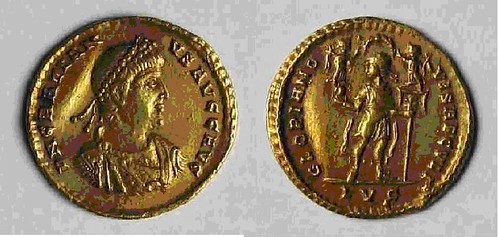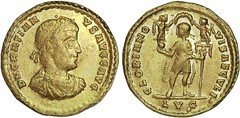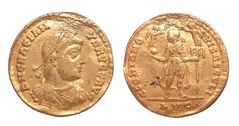
PREV ARTICLE
NEXT ARTICLE
FULL ISSUE
PREV FULL ISSUE
QUERY: GRATIANUS SOLIDUS FROM THE LYONS MINT
Philippe de Henaut submitted this query about a rare coin he's been researching. Can anyone cite additional specimens?
-Editor
In 2007, I acquired a very rare Gratianus Solidus from the Lugdunum (Lyons) Mint. At the time it was believed that there were only two known specimens, the ones described and illustrated by Pierre Bastien in "Le Monnayage de l'Atelier de Lyon (363-413)" and his subsequent volume "Le Monnayage de l'Atelier de Lyon (43 AV. J.-C. - 413 APR J.-C.), Supplément II". He assigned No. 58 to the specimen at Cabinet des Médailles de la Bibliothèque nationale de France (BnF) in Paris, and No. 58b to the specimen I acquired. While searching for more information on my new acquisition, I found out that Georges Depeyrot also cited two specimens, the one at the BnF, and one supposedly from the Dresden Museum for which he gave no information (and which led to speculation about its existence). These are cited in "Les Monnaie d'Or de Constantin II à Zénon (337-491)", and in L'Or du Bas-Empire, Inventaire Justificatif des Tomes 1 et 2". Intrigued about the possible existence of a third specimen, I decided to contact the Dresden Museum (Münzkabinett, Staatliche Kunstsammlungen Dresden) to verify that a Gratian solidus from the Lyon Mint was in fact in their possession. Wilhelm Hollstein graciously provided details and pictures of their specimen. It will be published in Bastien's Supplèment III, which is due to come out in 2010. The three specimens were featured on page 168 of the October 2008 issue of the Bulletin de la Société Française de Numismatique (BSFN). I have attached an English translation of the article I wrote, which gives background information and details of these specimens. If anyone has, or knows about, another specimen of this extremely rare solidus from the Lyon Mint, I would be very happy to have details and pictures sent to pdehenaut@peoplepc.com.
Below is the translation of Philippe's article.
-Editor
The Unique Gratian Solidus from the Lugdunum (Lyon) Mint by de Hénaut, Philippe Introduction Flavius Gratianus was born in AD359 in Sirmium in the roman province of Pannonia. He was elevated by his father to the title of Augustus at the age of eight, the first emperor's son to be thus elevated without first receiving the title of Caesar. In commemoration of this great event, as well as the concurrent quinquennalia of his father Valentinian I and his uncle Valens, the Lugdunum Mint issued in AD368 the only known type of solidus for Gratian to come from that mint. To date only three specimens are known to exist, one of which is unpublished. The glory of a new century With this exceptional issue, the hope of a new century is placed upon Gratian with the unusual reverse legend GLORIA NOVI SAECVLI, and ties him to the secular mysticism of the empire. The representation of Victory atop the labarum is particularly interesting, and confirms that the Christian emblem dispenses military successes to the Augusti. The equally unusual title AVGG AVG on the obverse has led former numismatists (notably A. Banduri and J. Eckhel, among others) to speculate as to its meaning, giving rise to diverse interpretations. Because of Gratien's young age at the time, he was not placed on equal footing with his co-regents, leading the mints at Lyon and Arles to characterize this inferiority by the expression Augustorum Augustus (loosely translated as Augustus born of Augusti). The known specimens The obverse and reverse legends are identical on each of the three known specimens, as shown in the table below. The busts and devices are more or less similar (see Figures below). Obverse
Reverse
Two of the specimens were described and illustrated by Pierre Bastien. He assigned No. 58 to the specimen at Cabinet des Médailles de la Bibliothèque nationale de France (BnF) in Paris (Fig. 1), and No. 58b to the specimen currently in a private collection (Fig. 2). Georges Depeyrot also cited two specimens, the one at the BnF, and one supposedly from the Dresden Museum for which he gave no information, and which led to speculation about its existence. Communications were established between the author and the Dresden Museum (Münzkabinett, Staatliche Kunstsammlungen Dresden) in January 2008 for the purpose of verifying that a Gratian solidus from the Lyon Mint was in fact in their possession. Wilhelm Hollstein graciously provided details and pictures of their specimen (Fig. 3). By the same token, Dominique Hollard of the BnF was equally agreeable to provide details and pictures of their specimen. For the three known solidi there are three obverse dies and two reverse dies (The BnF specimen and the private collection specimen are from the same reverse die). The BnF specimen seems to have suffered an ancient blow from a spade or other agricultural implement according to Dominique Hollard. The Dresden specimen was possibly pierced and mounted as jewelry. The provenance of either of these two specimens is unknown. The private collection specimen came from Alain Baron's Numismatica Genevensis 1 sale of 27 November 2000, No. 178, via the Compas collection. Other details of each specimen follows:
If anyone has another specimen of this extremely rare solidus from the Lyon Mint, the author would be very happy to have details and pictures sent to pdehenaut@peoplepc.com.

Fig. 1 - Specimen from the Cabinet des Médailles de la Bibliothèque nationale de France, © BnF

Figure 2 - Specimen from a private collection, © CGB

Figure 3 - Specimen from Münzkabinett, Staatliche Kunstsammlungen Dresden, © Dresen Wayne Homren, Editor The Numismatic Bibliomania Society is a non-profit organization promoting numismatic literature. See our web site at coinbooks.org. To submit items for publication in The E-Sylum, write to the Editor at this address: whomren@gmail.com To subscribe go to: https://my.binhost.com/lists/listinfo/esylum All Rights Reserved. NBS Home Page Contact the NBS webmaster 
|